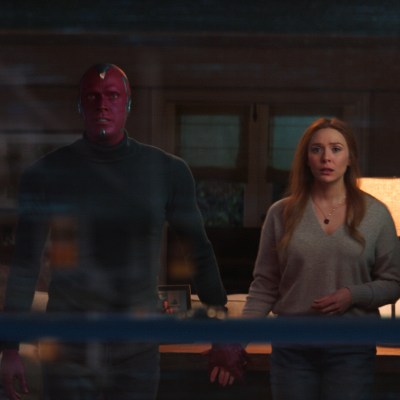WandaVision: Ship of Theseus Explained
Amid all the action in the WandaVision finale, the show takes a break to introduce a famous philosophical concept. What is the Ship of Theseus and what could it mean for the MCU?

This article contains spoilers for WandaVision episode 9.
Much of WandaVision’s ninth and final episode, fittingly titled “The Series Finale”, centers on a good old-fashioned synthezoid battle. In one corner, you have The Vision, lovingly recreated by Wanda Maximoff’s Mind Stone-infused powers. In the other corner is The White Vision, hatefully brought back to life by billions upon billions of the U.S. government’s dollars (and some fairy dust).
The two Visions’ battle takes them through every corner of the hex surrounding Westview, destroying oodles of property in the process. It seems as though the two Visions are so well-matched that this battle will never end. But that’s when our familiar red Vision decides to engage White Vision with FACTS and LOGIC instead of pure might.
“Are you familiar with the thought experiment, ‘The Ship of Theseus?’ in the field of identity metaphysics?” Vision asks White Vision.
“Naturally,” White Vision responds. He then offers up a brief primer on the Ship of Theseus, for both Vision’s sake and the audience:
“The Ship of Theseus is an artifact in a museum. Over time, its planks of wood rot and are replaced with new planks. When no original plank remains is it still the Ship of Theseus?”
White Vision’s Ship of Theseus explanation is a good one but it’s still worth expanding upon the concept further. The Ship of Theseus is quite simply one of the most pervasive and important philosophical concepts of all time. By understanding it and unpacking it fully, we may get an idea of just how deep the rabbit hole goes for the nature of identity in the Marvel Cinematic Universe.
The Ship of Theseus is a thought experiment so old that it’s not even clear who thought of it in the first place. The best known version of the puzzle (and the reason it’s often referred to as The Ship of Theseus) comes from Greek philosopher Plutarch who recounts the concept from Greek legend. He writes:
“The ship wherein Theseus and the youth of Athens returned from Crete had thirty oars, and was preserved by the Athenians down even to the time of Demetrius Phalereus, for they took away the old planks as they decayed, putting in new and stronger timber in their places, insomuch that this ship became a standing example among the philosophers, for the logical question of things that grow; one side holding that the ship remained the same, and the other contending that it was not the same.”
What Plutarch is essentially asking here is “how often can you replace a part of something before it constitutes a new whole?” Since this is the MCU, let’s apply that logic to SHIELD’s surprisingly destroyable Helicarrier. Let’s say The Hulk destroys the powerful turbines that keep the helicarrier afloat, so SHIELD replaces them. Then The Chitauri invasion destroys the long runway atop the helicarrier so SHIELD replaces that. Finally, a HYDRA virus wrecks the internal computer system on the ship and that must be replaced as well. Do we have an entirely new helicarrier at this point? If so, at which point did the first helicarrier cease to be itself and become a new helicarrier?
The Ship of Theseus thought experiment doesn’t always need to apply to a ship, obviously. It’s applicable to anything with replaceable parts. And the point of it all isn’t just to get in the weeds on the nature of carpentry and ship-building – it’s to delve deeper into the philosophical realms of identity and cognition. There is really no right answer to this question….or at least none that we’ve found yet. But that’s what makes the question worth asking.
What’s interesting, however, is that both The Vision and The White Vision seem to settle on an answer as it applies to themselves. After White Vision shares his textbook definition of the Ship of Theseus and its rotting planks, Vision hits him with another hypothetical.
“Secondly, if those removed planks are restored and reassembled, free of the rot, is that the Ship of Theseus?” he asks.
Grim recognition flashes across White Vision’s pearly face as he says “Neither is the true ship. Both are the true ship.”
White Vision has been tasked with SWORD to “eliminate Vision.” In this moment he realizes that there might not even be such a thing as “The Vision.” And if there is, he is just as likely to fit the description himself.
Both Visions then run through the crucial items that they’re missing in their Vision identity. White Vision does not have the Mind Stone. And the original Vision doesn’t have one single ounce of original material. He was built, whole cloth, from Wanda’s imagination.
In many ways, these two Visions are just continuing a conversation that began in Avengers: Infinity War. When it became clear that the Mind Stone must be destroyed before Thanos could get his beefy fingers on it, Vision and the rest of the Avengers naturally wondered if Vision’s identity would survive the destruction. Bruce Banner and Shuri were both adamant that there was more to Vision than just the Mind Stone. Now it’s clear that The Vision believes they were right.
This White Vision doesn’t need the Mind Stone to be The Vision. But he does need something…and Vision figures it out quickly.
“Perhaps the rot is the memories. The wear and tear of the voyages. The wood touched by Theseus himself,” he says.
He then restores White Vision’s memories that SWORD has hidden deep within his code. White Vision regains a sense of self immediately.
“I am Vision,” he says.
And so he is! He flies out of Westview, presumably to rejoin the Marvel Cinematic Universe in earnest, leaving this shade of a Vision to crumble once the hex does.
Vision’s interpretation of the Ship of Theseus is fascinating and not one that I’ve personally heard before (though that’s on me, someone else has certainly had that interpretation and shared it before at some point in human history). He argues that the thought experiment is too hung up on the ship as an inert, passive object. It doesn’t matter when the ship ceased to be the Ship of Theseus because we know when it was. The rot on the planks is not merely something to be replaced but rather evidence that the ship, in fact, lived. It’s The Ship of Theseus from a human perspective…communicated by a synthezoid.
Vision’s Ship of Theseus should prove to be important as Marvel continues on into Phase 4 and beyond. The longer that the Marvel Cinematic Universe persists, the more likely we are to see older characters return. Some characters, like Vision, will return from the dead. Some other characters may even be recast (paging Ralph Bohner!).
When this happens, it will be incumbent upon the MCU to ensure that the character resurrections or changes make sense within their canon. Thanks to Vision’s Ship of Theseus, we now know how they can make each character retcon work. As long as a particular character retains their experiences, there is no reason why they cannot retain their identity…regardless of what they may look like.
It’s all about “the rot of memory.”


